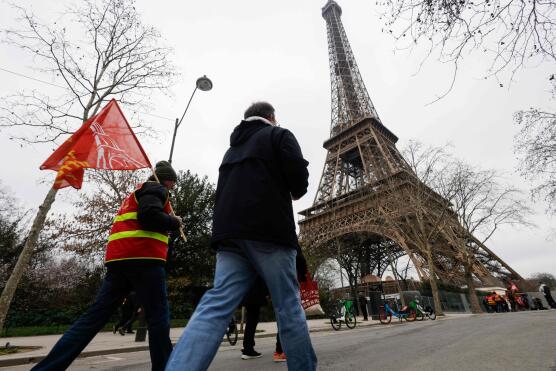
Paris, February 21, 2024: The iconic Eiffel Tower, a symbol of Parisian allure and architectural marvel, remains shrouded in silence for the third consecutive day yesterday, as a labor strike grips its operations.
Visitors who had dreamt of ascending the wrought iron lattice to behold the City of Light from its lofty heights are met with disappointment, as the ongoing dispute over financing and maintenance casts a shadow over the monument’s future.
The strike, which commenced on Monday, has been driven by the collective discontent of the tower’s staff, decrying what they perceive as insufficient investment in the upkeep of this global landmark.
It marks the second such protest within a span of two months, underlining the persistent concerns surrounding the Eiffel Tower’s financial sustainability.
At the heart of the dispute lies a clash between the tower’s operator, SETE, and labor unions, who accuse SETE of banking on inflated projections of future visitor numbers while neglecting the crucial aspect of repair and maintenance costs.
With Paris poised to welcome the world for the upcoming Olympic Games, the pressure mounts to ensure that this emblematic structure stands as a testament to the city’s grandeur and hospitality.
The pandemic-induced disruptions have dealt a severe blow to the Eiffel Tower’s fortunes, causing a significant downturn in visitor numbers.
Despite this setback, the tower witnessed a modest resurgence, attracting 5.9 million visitors in 2022 and 6.3 million in the following year.
However, the specter of financial strain looms large, exacerbated by the reluctance of city officials to alleviate the burden on SETE by renegotiating leasing fees deemed exorbitant by union representatives.
“We urge the city of Paris to reconsider its financial demands, recognizing the imperative of preserving this cultural icon,” implored union spokespersons, echoing the sentiments of many who fear for the future of the Eiffel Tower.
The standoff between labor representatives and municipal authorities underscores the gravity of the situation, with the fate of one of the world’s most recognizable landmarks hanging in the balance.
The Eiffel Tower’s closure reverberates beyond the realm of tourism, serving as a stark reminder of the delicate equilibrium between cultural heritage and commercial viability.
While the allure of the tower as a tourist magnet remains undiminished, the underlying infrastructure demands meticulous attention and substantial investment to ensure its longevity.
SETE, grappling with a staggering deficit of approximately 120 million euros incurred during the pandemic-induced downturn, finds itself at a crossroads.
Despite a recent infusion of 60 million euros in recapitalization, union leaders insist that this amount falls short of the mark, given the magnitude of maintenance work required, including a much-needed repaint to preserve the tower’s timeless elegance.
As negotiations stall and tensions escalate, the Eiffel Tower stands as a microcosm of broader debates surrounding heritage preservation, public-private partnerships, and the economic imperatives of the tourism industry.
The resolution of this impasse holds far-reaching implications, not only for the immediate future of the Eiffel Tower but also for the broader discourse on the intersection of culture, commerce, and civic responsibility.
In the meantime, prospective visitors are advised to monitor SETE’s website for updates or consider postponing their pilgrimage to this architectural marvel.
As the sun sets on another day of uncertainty, the Eiffel Tower stands as a silent sentinel, awaiting the resolution of a conflict that transcends its iron lattice and touches the very soul of Paris.
This article was created using automation technology and was thoroughly edited and fact-checked by one of our editorial staff members